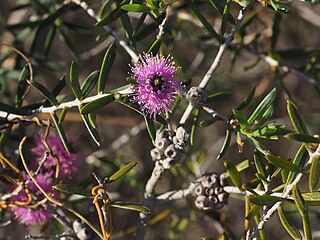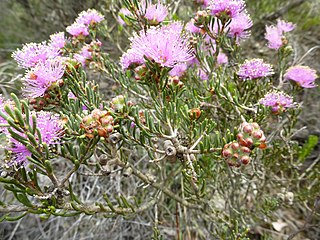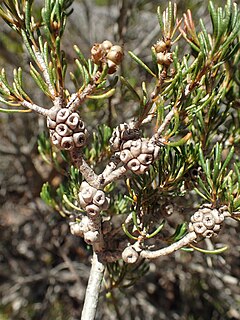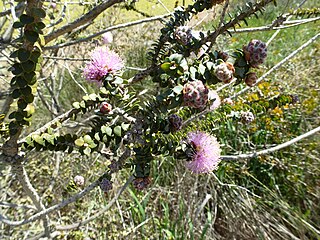Melaleuca penicula is a plant in the myrtle family, Myrtaceae and is endemic to the south of Western Australia. It is a rare species only known from the Fitzgerald River National Park and resembles Melaleuca eximia with its spikes of red flowers but its leaves and stamen bundles are different.

Melaleuca amydra is a plant in the myrtle family, Myrtaceae and is endemic to the south-west of Western Australia. It is similar to Melaleuca ryeae with its small, compact form, oval leaves and "pom-pom" heads of pink to purple flower heads on the ends of the branches in spring.

Melaleuca beardii is a plant in the myrtle family, Myrtaceae and is endemic to the south-west of Western Australia. It is similar to a number of other Western Australian melaleucas such as M. trichophylla with its purple pom-pom flower heads but unlike others, the tips of its leaves are rounded rather than pointed.
Melaleuca boeophylla is a plant in the myrtle family, Myrtaceae and is endemic to the south-west of Western Australia. It is similar to a number of other Western Australian melaleucas such as M. filifolia with its purple pom-pom flower heads but its leaves are shorter and oval in cross-section.

Melaleuca caeca is a plant in the myrtle family, Myrtaceae and is endemic to the south-west of Western Australia. It is similar to a number of other Western Australian melaleucas such as M. pentagona with its purple pom-pom flower heads but it is a smaller shrub with narrower leaves and smaller inflorescences.

Melaleuca campanae is a plant in the myrtle family, Myrtaceae and is endemic to the south-west of Western Australia. It is a small, woody shrub similar to Melaleuca eulobata, with a low, spreading habit and pinkish flower heads but it has longer, pointed leaves and lacks distinct sepals which instead form a ring of tissue around the edge of the flowers.

Melaleuca carrii is a plant in the myrtle family, Myrtaceae and is endemic to the south-west of Western Australia. It is a small shrub similar to Melaleuca pentagona, with "pom-pom" heads of pinkish flowers and sharply pointed leaves but it is generally smaller, lacks a groove in its leaves and retains its petals on the flowers for longer than that species.

Melaleuca clavifolia is a plant in the myrtle family, Myrtaceae and is endemic to the south-west of Western Australia. It is a small shrub similar to Melaleuca tinkeri, with "pom-pom" heads of pinkish flowers and soft, silky hairs on the new growth but it has larger flower heads and its leaves are shorter, more club-shaped and have less distinct oil glands.

Melaleuca calyptroides is a plant in the myrtle family, Myrtaceae and is endemic to the south-west of Western Australia. It is similar to a number of other Western Australian melaleucas such as M. hollidayi with its almost cylindrical leaves, purple pom-pom flower heads and low growth habit but it has longer, wartier leaves and fewer flowers in the inflorescences. The floral cup and woody capsule from which it develops are longer than those of similar melaleucas.
Melaleuca eulobata is a plant in the myrtle family, Myrtaceae and is endemic to the west coast of Western Australia. It is a shrub resembling Melaleuca campanae with its heads of pink flowers in late spring but is distinguished from that species by its sepals - in M. campane these are reduced to a ring of tissue but M. eulobata has distinct calyx lobes.

Melaleuca fabri is a plant in the myrtle family, Myrtaceae and is endemic to the south-west of Western Australia. It features strap-like leaves with distinct veins and spikes of pinkish flowers, the buds of which are covered with short, soft, silky hairs.

Melaleuca glena is a plant in the myrtle family, Myrtaceae and is endemic to the south of Western Australia. It is similar to the commonly cultivated Melaleuca nesophila with its purple "pom-pom" flower heads but is a smaller shrub with the inflorescences much more often on the sides of the branches and only occasionally on the ends.

Melaleuca hollidayi is a plant in the myrtle family, Myrtaceae and is endemic to the south of Western Australia. It is a small shrub with fine hairs like spider web on its leaves, and bright pink flowers.

Melaleuca linguiformis is a plant in the myrtle family, Myrtaceae and is endemic to the south of Western Australia. It is a shrub with hairy new growth, small leaves and heads of white flowers similar to Melaleuca teuthidoides shorter sepals and more stamens in each flower.

Melaleuca orbicularis is a plant in the myrtle family, Myrtaceae and is endemic to the south-west of Western Australia. It is similar to Melaleuca cordata with its pinkish "pom-pom" heads of flowers but its leaves are smaller, almost circular compared to the heart shaped leaves of the other species.

Melaleuca osullivanii is a plant in the myrtle family, Myrtaceae and is endemic to the south-west of Western Australia. It was first formally described in 2004 after a review of the broombush group, Melaleuca uncinata. It differs from others in the group by having leaves that are fine and circular in cross section. The closest other broombrush is Melaleuca hamata whose leaves are 0.8–1.6 mm (0.03–0.06 in) in diameter compared to 0.7–0.9 mm (0.03–0.04 in) for this species.
Melaleuca similis is a plant in the myrtle family, Myrtaceae and is endemic to the south west of Western Australia. It is a small shrub, similar to Melaleuca stramentosa with its narrow, almost cylindrical leaves and heads of pink to purple flowers but lacks the matted, silky hairs on the young leaves and outer edge of the flower cup.

Melaleuca societatis is a plant in the myrtle family, Myrtaceae and is endemic to the south west of Western Australia. It is a dwarf shrub with small, fleshy leaves and many heads of pink or purple flowers in spring, followed by "soccer-ball" fruit.
Melaleuca stramentosa is a plant in the myrtle family, Myrtaceae and is endemic to the south-west of Western Australia. It is a small, bushy shrub similar to Melaleuca similis with its cylindrical leaves and heads of pink to purple flowers but differs in have matted, woolly hairs around the flowers and on the young leaves.

Melaleuca protrusa is a shrub in the myrtle family, Myrtaceae, and is endemic to the south-west of Western Australia. It is a shrub with papery bark, narrow leaves with a hooked end and cream-coloured or yellow flowers. Although it was described as late as 2010, it is not considered a rare or endangered species. It resembles other members of the brushwood group such as M. uncinata, M. atroviridis and M. zeteticorum.
















